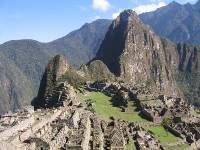Profile
Blog
Photos
Videos
Hi everyone. Just 10 short days left now of our wee trip but we have been making the most of our remaining time.
In our last blog we were in Potosi, Bolivia, the highest city in the world. On our last day there we visited the famous silver mines, which are a UNESCO heritage site in recognition of their long but tragic history. Working practices have changed little over the years. Minerals are extracted by hand, ton loads of rock are transported by manpower and there is little ventilation. We spent 2 hours underground and breathing was hard so it was easy to believe that a miner is only expected to live for ten years after he first starts working in them. At least the most senior miners earn more than the Bolivian president. We also learned that the miners worship the devil! They believe that God is good in light but that the devil is good in the dark. So as soon as they lose sight of daylight they cross themselves, then pray that the devil will keep them safe in the mines.
We then moved on to the city of Sucre, the nicest town in Bolivia by far. It is easily explored on foot, and its beautiful whitewashed colonial architecture made it a great place to hang out for a few days.
After Sucre we traveled to the city of Cochabamba, which has a Burger King, a McDonalds, the worlds biggest statue of Christ and not much else, it was really just a stopping point on the way to the capital, La Paz. La Paz is dirty, smelly, chaotic, but totally addictive and we had a great few days there. Sarah as usual hit the markets while some of the guys went to see a football match. Oriente vs the wonderfully named The Strongest. Marcel knew a former player so I was given a personal tour of the stadium and even got to stand on the pitch. The match itself was a typically South American affair with flying elbows and knees and coaches being escorted of the field by riot police. My new favourite team The Strongest won 2-1. A few of us also visited what is aparentely South Americas strangest jail, San Pedro in the heart of La Paz. Here we were given a tour by a couple of drug trafficking South Africans for 250 bolivianos, most of which goes to bribing the guards to allow it to happen. Inmates who can afford it can buy their own cell, which they are then free to fill with TVs, radios, Playstations, escort girls etc. Wives and even children live in the prison as well, who leave each day to go to school. There are restaurants, takeaways and shops run by the inmates too. It was amazing to see such a place but there was still a hint of relief when we were let out by the guards! Also in La Paz we had a definite highlight of our trip, a mountain bike ride down what is known as Death Road. The road is gravel, 2 way, 3 metres wide and has no barriers against a 600ft plunge down the side. 100 people year die on it, hence its name. We however hurtled down it at lightning speed, one guy in our group, David even went faster than the guide. It was such an adrenaline rush, and no one got hurt. Although we did see a few people fall off and one girl who had split her leg open. Our last day in La Paz was spent exploring the Witches markets, where you could buy local crafts, various potions and tat and also llama foetus. We said goodbye to some of our group that night including our brilliant guide Marcel, who has since been replaced by Fernando.
The next day we arrived in Peru, the tenth and final country of our journey. Our base for a few days was the town of Puno, on the shores of Lake Titicaca. We took a boat out onto the lake, stopping at various islands along the way. That night we were staying in a small village, where we were the guests of a local Quechua family. I couldnt quite make out our hosts name but with our limited Spanish we found out he was 58, had lived by the lake all his life, had 5 children including 4 year old Juan Carlos who lived with him and his wife, and worked in ecotourism. In exchange for some gifts of fruit he gave us a bed for the night and a nice homecooked meal. In the evening we dressed in local costume and looking like silly gringos had a fiesta with the locals. There was also a football match but the less said about that the better. Its the altitude I tell you! On our way back to Puno the next day we visited the floating islands, amazing stuctures made of reeds bound together, housing entire villages on them, where the people live in huts also made of reeds.
We had a relatively short 6 hour bus ride the next day to our present location of Cusqo, the capital city of the once great Inca empire. Today it is the tourist capital of Peru but retains a lot of its charm. There are still lots of original Inca buildings standing today, the main square, Plaza del Armas, in particular is beautiful. It was also the base for our group to tackle the Inca Trail to Macchupichu, which Sarah shall tell you all about tomorrow.
Love Blair and (Sarah) xxx
PS photos from the last month will go up when we get home on the 6th Aug
- comments




